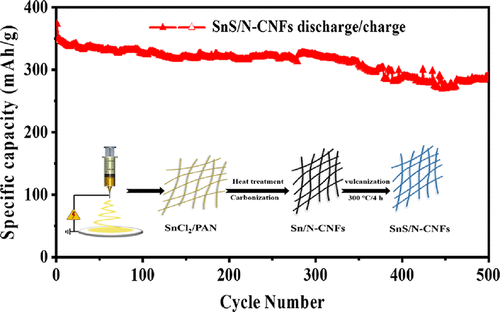当前位置:
X-MOL 学术
›
Energy Fuels
›
论文详情
Our official English website, www.x-mol.net, welcomes your
feedback! (Note: you will need to create a separate account there.)
Nanostructures of Carbon Nanofiber-Constrained Stannous Sulfide with High Flexibility and Enhanced Performance for Sodium-Ion Batteries
Energy & Fuels ( IF 5.2 ) Pub Date : 2022-01-27 , DOI: 10.1021/acs.energyfuels.1c04053 Long Qing 1, 2 , Rui Li 1, 2 , Wei Su 1, 2 , Wei Zhao 1, 2 , Yuming Li 1, 2 , Ge Chen 1, 2 , Naiqiang Liu 1, 2 , Jian Chen 1, 2
Energy & Fuels ( IF 5.2 ) Pub Date : 2022-01-27 , DOI: 10.1021/acs.energyfuels.1c04053 Long Qing 1, 2 , Rui Li 1, 2 , Wei Su 1, 2 , Wei Zhao 1, 2 , Yuming Li 1, 2 , Ge Chen 1, 2 , Naiqiang Liu 1, 2 , Jian Chen 1, 2
Affiliation

|
Stannous sulfide (SnS) still faces the challenge of dramatic volume changes during discharge/charge, which results in the appearance of fractures and pulverization of the electrode and rapid capacity attenuation of the sodium-ion batteries (SIBs). To handle this issue, SnS nanoparticles are embedded in nitrogen-doped carbon nanofibers (N-CNFs) during the calcination of electrospun nanofibers to construct nanostructures of SnS/N-CNFs, which are directly used as anodes for SIBs. The carbon structure formed by electrospun nanofibers restricts the growth of SnS, promotes uniform dispersion of SnS, and prevents the volume effect of SnS during the charge and discharge in SIBs. Moreover, the SnS/N-CNFs are interconnected to form a three-dimensional (3D) network, thus revealing a high degree of flexibility and an ability to withstand repeated 180° bending and loads hundreds of times heavier than itself. In addition, SnS/N-CNFs also form an interconnected 3D conductive network. Benefiting from the confinement of N-CNFs, the SnS/N-CNFs provide a high capacity and excellent cycling performance of 422 mA h g–1 at a current density 100 mA g–1 after 150 cycles and maintain a reversible capacity of 292 mA h g–1 even at high current density of 500 mA g–1. The outstanding flexibility and enhanced electrochemical performance of free-standing SnS/N-CNFs would make them potential anodes for flexible SIBs.
中文翻译:

用于钠离子电池的高柔韧性和增强性能的碳纳米纤维约束硫化亚锡的纳米结构
硫化亚锡(SnS)仍然面临着放电/充电过程中体积急剧变化的挑战,这会导致电极出现断裂和粉化以及钠离子电池(SIB)的容量快速衰减。为了解决这个问题,在电纺纳米纤维的煅烧过程中,将 SnS 纳米颗粒嵌入氮掺杂碳纳米纤维 (N-CNFs) 中,以构建 SnS/N-CNFs 的纳米结构,直接用作 SIBs 的阳极。电纺纳米纤维形成的碳结构限制了 SnS 的生长,促进了 SnS 的均匀分散,并防止了 SIBs 在充放电过程中 SnS 的体积效应。此外,SnS / N-CNF相互连接以形成三维(3D)网络,从而显示出高度的灵活性和承受反复 180° 弯曲和比自身重数百倍的负载的能力。此外,SnS/N-CNFs 还形成互连的 3D 导电网络。受益于 N-CNF 的限制,SnS/N-CNF 提供了 422 mA hg 的高容量和出色的循环性能–1在 100 mA g –1的电流密度下循环 150 次后,即使在 500 mA g –1的高电流密度下也能保持 292 mA hg –1的可逆容量。独立式 SnS/N-CNF 出色的柔韧性和增强的电化学性能将使其成为柔性 SIB 的潜在阳极。
更新日期:2022-01-27
中文翻译:

用于钠离子电池的高柔韧性和增强性能的碳纳米纤维约束硫化亚锡的纳米结构
硫化亚锡(SnS)仍然面临着放电/充电过程中体积急剧变化的挑战,这会导致电极出现断裂和粉化以及钠离子电池(SIB)的容量快速衰减。为了解决这个问题,在电纺纳米纤维的煅烧过程中,将 SnS 纳米颗粒嵌入氮掺杂碳纳米纤维 (N-CNFs) 中,以构建 SnS/N-CNFs 的纳米结构,直接用作 SIBs 的阳极。电纺纳米纤维形成的碳结构限制了 SnS 的生长,促进了 SnS 的均匀分散,并防止了 SIBs 在充放电过程中 SnS 的体积效应。此外,SnS / N-CNF相互连接以形成三维(3D)网络,从而显示出高度的灵活性和承受反复 180° 弯曲和比自身重数百倍的负载的能力。此外,SnS/N-CNFs 还形成互连的 3D 导电网络。受益于 N-CNF 的限制,SnS/N-CNF 提供了 422 mA hg 的高容量和出色的循环性能–1在 100 mA g –1的电流密度下循环 150 次后,即使在 500 mA g –1的高电流密度下也能保持 292 mA hg –1的可逆容量。独立式 SnS/N-CNF 出色的柔韧性和增强的电化学性能将使其成为柔性 SIB 的潜在阳极。

















































 京公网安备 11010802027423号
京公网安备 11010802027423号